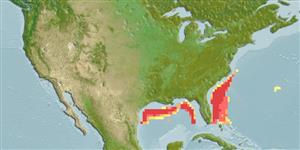Malacostraca |
Decapoda |
Geryonidae
Environment: milieu / climate zone / djupintervall / distribution range
Ekologi
; djupintervall 200 - 2002 m (Ref. 101759). Deep-water; 7°C - 16°C; 38°N - 23°N, 88°W - 64°W
Western Atlantic: South Atlantic Bight, the Gulf of Mexico and Bermuda.
Length at first maturity / Size / Weight / Age
Könsmognad: Lm ?, range 9 - 16.9 cm Max length : 19.0 cm CW hane/ej könsbestämd; (Ref. 101836); publicerad maxvikt: 2.0 kg (Ref. 101836)
Carapace broader than long. Median pair of frontal teeth separated by a wide sinus, teeth scarcely overreaching obtuse lateral frontal teeth. Orbits usually more than 3/4 frontal width. Anterolateral teeth 5, second and fourth reduced, distance between first and third usually smaller than distance between third and fifth. Cheliped with blunt lobe on upper margin of merus, carpus lacking outer spine, propodus lacking distal dorsal spine. Meri of pereiopods lacking distal dorsal spine. Fifth leg: merus broad, less than 2/3 carapace width; propodus broad, length less than 4.5 times width; propodus and dactylus subequal in length, or dactylus slightly longer. Dactili of pereiopods compressed, narrow, height at midlength much greater than width. Color: tan to cream.
Maximum depth from Ref. 97531 Inhabits the continental slope on flat foraminiferan ooze habitat, coral mounds, ripple habitat, dunes, black pebble habitat, rock outcrops, and soft-bioturbated habitat (Ref. 367). Also in muddy and muddy-sandy bottoms (Ref. 101384). Opportunistic feeder (Ref. 104380).
Life cycle: Eggs are incubated for approximately six months after which the larvae hatch. Mating behavior: Mating occurs immediately after the female's molting. Precopulatory behavior is characterized as the formation of a protective cage around the female by the male using its legs.
Tavares, M. 2003 True Crabs. pp. 327-352. In Carpenter, K.E. (ed.) The living marine resources of the Western Central Atlantic. Volume1: introdution, molluscs, crustaceans, hagfishes, sharks, batoid fishes, and chimaeras. FAO Species Identification Guide for Fishery Purposes and American Society of Ichthyologists and Herpetologists Special PublicationNo. 5. Rome, FAO. pp. 1-600. (Ref. 367)
IUCN Red List Status
(Ref. 130435: Version 2025-1)
CITES status (Ref. 108899)
Not Evaluated
Not Evaluated
Threat to humans
Human uses
Fiskeri: kommersiell
| FishSource |
Verktyg
Ytterligare information
Trophic EcologyFood items (preys)
Födosammansättning
Födointag
Predatorer
Human RelatedStamps, coins, misc.
Internet-källor
Estimates based on models
Preferred temperature
(Ref.
115969): 6.5 - 14.5, mean 11.1 (based on 45 cells).
Fishing Vulnerability
Low vulnerability (10 of 100).
Price category
Unknown.
